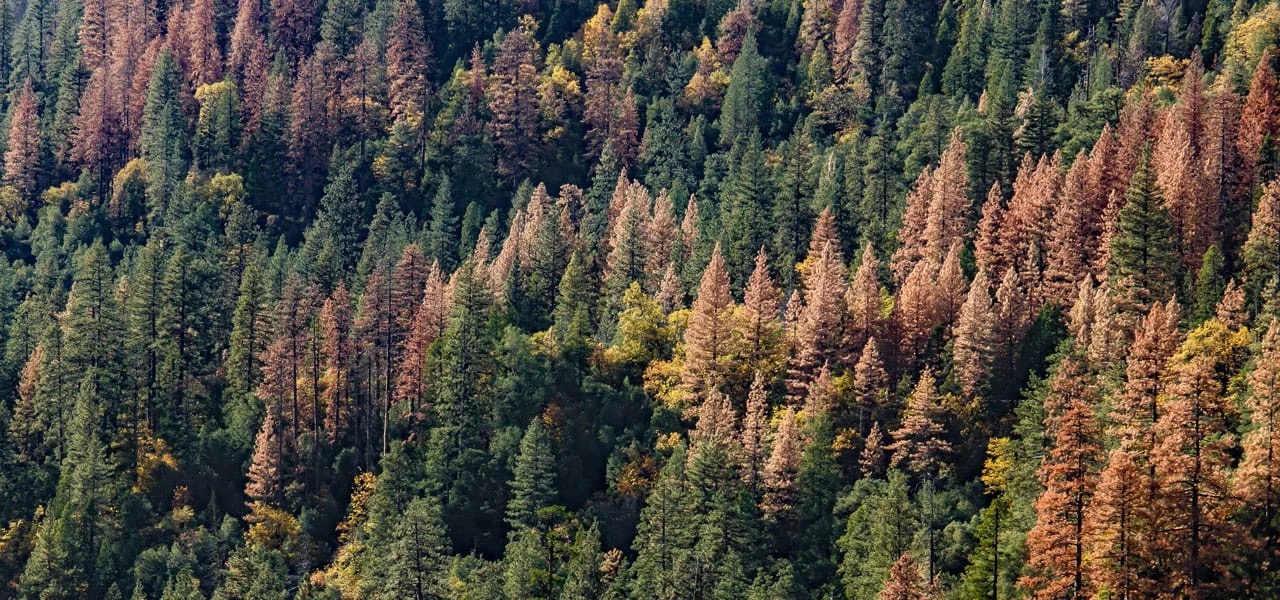If you’re wondering whether fall colors in Colorado are appearing earlier than usual this year, the answer is “yes”.
This year, about 75% of Colorado is experiencing drought. In our area, Jefferson county is “abnormally dry”, while most of Park and Clear Creek counties are in moderate or severe drought conditions. You can see the latest drought map here >>
As a result, leaves are changing color earlier than they normally do and will probably stay on the trees less than the typical 2 weeks. The early leaf change is particularly noticeable in our iconic aspens, as entire groves have already turned yellow.
Drought can have different effects on trees depending on the length and severity of the drought, as well as the tree species. Some trees change color earlier, others later, and yet others just turn brown instead of producing brilliant fall colors.
Why Leaves Change Color in Fall
During the spring and summer, tree leaves are (mostly) green. That’s due to chlorophyll, a substance in leaves that’s a key part of the photosynthesis that provides trees with food during the growing season.
As days shorten and temperatures fall, chlorophyll production slows and eventually stops as trees prepare for winter dormancy.
Without chlorophyll to mask their colors, orange carotenoids and yellow xanthophylls become visible in some tree species (such as serviceberry and aspens). In others, anthocyanins start to be produced, turning leaves red and purple (you’ll see this in maples and sumac).
Eventually, all of these pigments break down, leaving only brown tannins before the leaves finally drop.
Of course, it’s not always that simple; weather conditions also affect how trees react in fall.
How Drought Conditions Change Fall Leaf Coloration
Whether a tree goes through the leaf coloration process in autumn, and how long it lasts, depends to a large extent on spring and summer growing conditions.
Severe drought during the growing season usually makes tree leaves change color earlier and the color lasts for a shorter period. Some trees respond to drought stress by skipping the fall color change altogether; leaves just turn brown and fall off quickly.
Moderate drought has a different effect; it tends to delay the onset of fall color.
How Heat Stress Affects Fall Leaf Color
Like drought, severe heat stress can contribute to the early coloration, browning, and loss of leaves.
When late summer and fall temperatures are moderately elevated, the change to fall colors can be delayed because trees aren’t getting the signal that fall has arrived.
Nighttime temperatures also affect the brightness of red and purple leaves; warmer temperatures at night mute the red and purple colors as fewer anthocyanins are produced, while cooler nights amplify the colors.
Best Conditions for Fall Leaf Color
The best conditions for producing brilliant fall foliage is a spring and summer with plenty of moisture followed by a dry, cool and sunny autumn with warm days and cool but frostless nights.
The combination of sunny days and lower temperatures destroys chlorophyll more rapidly, letting yellow and orange pigments shine through. Cool nighttime temperatures increase the production of red and purple anthocyanins, but temperatures below freezing stop that process.
This fall, we’re expecting a short and muted leaf display in and around the Evergreen area.
If any of your trees are changing colors or dropping leaves early, it’s a sign that they’re stressed by the ongoing drought. Continue to water them throughout the fall, and even in winter, to help them recover. And keep your fingers crossed that next year will bring more rain to the Front Range!



